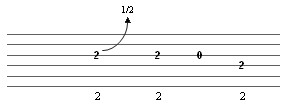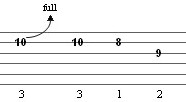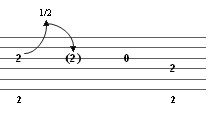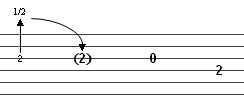When 2 or more notes occur one after the other on the same string the opportunity for a hammer on, pull off, slide or bend can be considered to add a different nuance to the phrase. Be particularly careful not to hurry the tempo by hammering on, pulling off, sliding or bending too soon. Wait until the first note has lasted its correct duration. Try to observe the exact time values as if the two notes were not slurred.
Hammer ons– A hammer on is achieved by plucking the first note, then hammering
down behind a fret that is further up the neck. It is important to:
-
Use a short, snapping down motion with the fingertip.
-
Start no more than 1/2 an inch above the fretboard.
-
Fingertip hammers down on the string just behind the fret, creating optimal continuance of the strings vibration.

Pull offs – A pull-off is achieved by plucking the first note, then pulling down and off the string creating a continuing vibration of the string to a note below the originally plucked note. The note below the originally plucked note could be either the open string or a note below the plucked note that was being held by another finger. It is important too:
-
Make sure the strings around the string you are performing the pull-off on are muted by available left and right hand fingers that aren’t doing anything. This helps the pull-off sound “clean”.
-
Perform the pull-off with the finger tip not the finger pad. This will ultimately produce a better sounding pull-off.

Slides – A slide is achieved by plucking a note then sliding the fingertip used to finger the note up or down to another fret. This creates a “glissando”. It is important too:
-
Maintain pressure on the string when sliding to keep the string vibrating.
-
Slide directly to the back of the destination fret.

Bends – A bend is achieved by plucking a note, then pushing the string up or pulling it down, thus raising the pitch of the note. It is one of the most expressive left techniques. Although there is much variety involved in bending notes, we will discuss just the most common bends here. It is important to:
-
Keep the string in constant contact with the fret while bending. This will require keeping pressure on the string.
-
When bending with all but the first finger, the remaining fingers will help with the bend. Example: If bending a note with 3rd finger, fingers 2 and 1 will line up behind finger 3 on the same string and help with the bend.
-
Make sure you are bending to the designated pitch. Generally a half or whole step above the source note.
The 4 most common types of bends are:
Half Step 
Whole Step 
Reverse
Bend 
Pre-Bend

Vibrato – Vibrato is produced when the plucked notes string is pushed up or down a little bit repeatedly. It is important to:
-
Keep constant pressure on the string so the note won’t die out prematurely.
-
Choose to push the sting up or pull the string down, not both, to produce vibrato.
-
Remember, vibrato is a very personal part of guitar playing. There is room for much variety. There is no “right” or “wrong” sounding vibrato. I will record a few common examples.